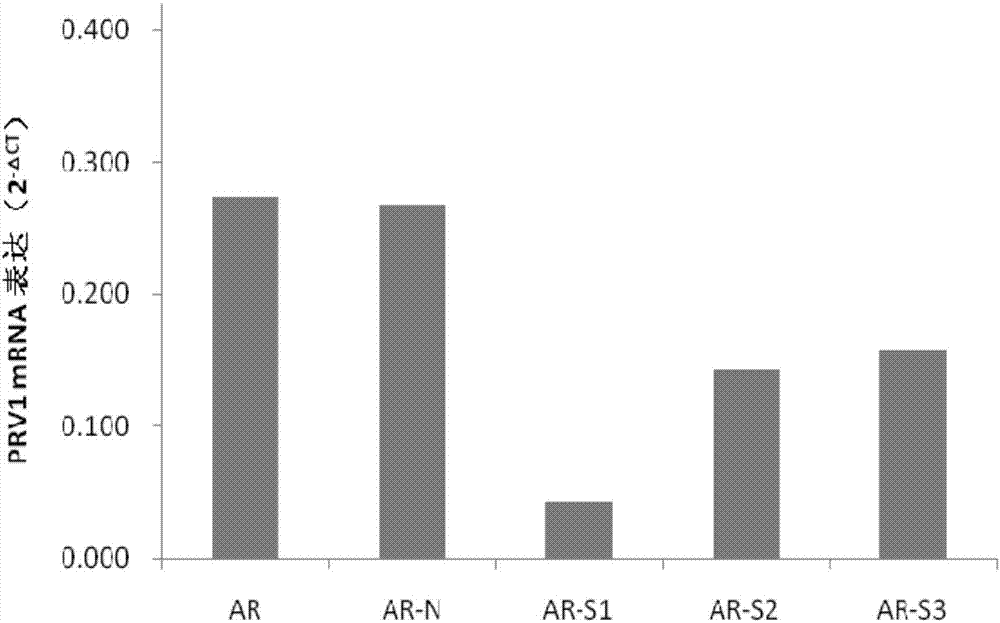SiRNA for specific inhibition of PRV1 gene expression and recombinant vector and application thereof
A technology for gene expression and recombinant vectors, applied in the fields of molecular biology and biomedicine, to achieve the effect of reducing tumor cell proliferation, inhibiting mRNA and protein expression, and reducing cell migration and invasion capabilities
- Summary
- Abstract
- Description
- Claims
- Application Information
AI Technical Summary
Problems solved by technology
Method used
Image
Examples
Embodiment 1
[0063] Example 1. Study on the difference of PRV1 expression in ovarian cancer cell line A2780 and its paclitaxel-resistant cell line A2780 / Taxol
[0064] 1. Detection of PRV1 gene mRNA expression by real-time fluorescent quantitative RT-PCR (qRT-PCR)
[0065] After culturing for 48 hours, the medium in the 6-well plate was discarded, washed twice with PBS, and the total RNA was extracted with Trizol. The RNA concentration was measured with a ThermoNano Drop2000 spectrophotometer, and the operation was performed according to the instructions of the SYBR Premix Ex Taq (perfect Real time) kit. . The first step is RNA denaturation, reaction system: RNA 0.5ug, RNase-free DEPC water to make up to 6.8ul; reaction conditions: incubate at 70°C for 10min and place on ice. The second step of reverse transcription, reaction system: perform reverse transcription according to the instructions of the PrimeScript RTMaster Mix kit; reaction conditions: incubate at 42°C for 60 minutes, inacti...
Embodiment 2
[0075] Example 2. Design and synthesis of PRV1 siRNA
[0076] The PRV1 gene mRNA sequence (NM_020406.3) was found in Genebank, and 3 pairs of siRNA sequences (such as SEQ ID NO.1-SEQ ID NO. 6) as shown. During the design process, select the sequences that satisfy the three algorithms (Ui-Tei×Reynolds×Amarzguioui) reported in the literature at the same time, and select the 23nt length fragment with the highest siRNA action specificity. This design can avoid interferon-like immune reactions in future in vivo experiments , choose 100nt after the start codon, avoid the 5' and 3' UTR regions, and control the GC content at 30-70%. A total of 3 pairs of siRNAs with a length of 23nt were selected as the experimental screening interference fragments. The structural characteristics are that there are two bases attached to the 3' end of the sense strand and the antisense strand.
[0077]
[0078] BLASTN (https: / / blast.ncbi.nlm.nih.gov / Blast.cgi) Homology searches were performed onli...
Embodiment 3
[0084] Example 3. Detection and screening of three pairs of PRV1 siRNAs on PRV1 gene interference in ovarian cancer paclitaxel-resistant strain A2780 / Taxol
[0085] 1. Experimental group:
[0086] 1. A2780 / Taxol normal group (not transfected with siRNA), hereinafter referred to as AR;
[0087] 2. A2780 / Taxol negative control group (transfection negative control siRNA), hereinafter referred to as AR-N;
[0088] 3. A2780 / Taxol experimental group (transfection S1), hereinafter referred to as AR-S1;
[0089] 4. A2780 / Taxol experimental group (transfection S2), hereinafter referred to as AR-S2;
[0090] 5. A2780 / Taxol experimental group (transfection S3), hereinafter referred to as AR-S3.
[0091] 2. Group transfection
[0092] In order to ensure transfection efficiency and reduce cytotoxicity, we used Lipofectamine3000 transfection reagent for siRNA transfection. The day before transfection, cells were trypsinized and counted, and the cells were plated in a six-well plate so ...
PUM
 Login to View More
Login to View More Abstract
Description
Claims
Application Information
 Login to View More
Login to View More - R&D
- Intellectual Property
- Life Sciences
- Materials
- Tech Scout
- Unparalleled Data Quality
- Higher Quality Content
- 60% Fewer Hallucinations
Browse by: Latest US Patents, China's latest patents, Technical Efficacy Thesaurus, Application Domain, Technology Topic, Popular Technical Reports.
© 2025 PatSnap. All rights reserved.Legal|Privacy policy|Modern Slavery Act Transparency Statement|Sitemap|About US| Contact US: help@patsnap.com



